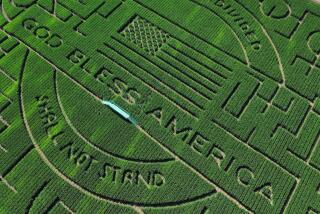Maize Maze Is New Path for Farmers
- Share via
FALLON, Nev. — Rick Lattin’s farm was bone dry and he was desperate. Years of drought in the Lahontan Valley had wilted his once-sturdy cornstalks into khaki-colored husks, prompting the third-generation farmer to seriously consider another career.
Then one night two years ago, while wandering the Internet, Lattin hit on a different--and, some warned, crazy--way to help turn things around at his 500-acre farm an hour east of Reno: He would carve labyrinthine paths into his rows of growing corn, creating a rural attraction that he hoped would draw curious city folks and locals alike.
He would build a corn maze.
“We had to find a way to draw more people out to the farm,” says Lattin. “Just selling produce from a roadside stand wasn’t getting it done. We were on our last legs.”
Under the guidance of a maze architect, Lattin and his family fashioned a five-acre cornfield maze in the shape of their home state. The Nevada maze has drawn 12,000 visitors in its first two years--families and school groups who pay $6 a head to negotiate miles of twisting trails--and the Lattins say their finances have improved considerably.
Lattin is among scores of farmers nationwide to join the maize maze trend, which has seen cornfields transformed into tourist draws from California to Maine. Many are owned by huge agriculture conglomerates looking for small ways to diversify, but others are on farms owned by people like Lattin, who sees the maze as a last-ditch effort to help rescue a struggling farm.
Even the U.S. government is behind the idea.
“For many farmers, creating a maze is a viable way to begin turning around troubled operations,” said Denis Ebodaghe, director of the U.S. Department of Agriculture’s small farms program. “We think it’s the wave of the future, because most people are looking for ways to earn some extra money.
“It’s a creative way to re-energize their income and their self-image as farmers, to draw people out to their farms so they can sell what they grow.”
For the Lattins, that means not only corn but barley, turnips, peppers, raspberries, summer squash and, Rick Lattin’s pride and joy, melons.
“My husband asked me to the junior prom and all he could talk about that night was how his melons would fare during the cold snap,” Beverly Lattin recalled of that evening more than 25 years ago. “So in our nice clothes he took me out to the fields that night to check on his melons. I sure knew I was marrying a farmer, all right.”
But the past 30 years as a farm family have often been tough for the Lattins. Like his father, Rick Lattin often worked a second job to make ends meet. Then three successive years of drought left him with no income at all. “Without all of us working,” says Beverly Lattin, “we would have gone under for sure.”
Then Lattin happened on the maze idea.
“I told him that I hoped he knew what he was doing,” said his father, Bill. “In all the years I farmed that land, I never dreamed that we’d be plowing paths and inviting strangers out into our fields. That was always just the farmer’s domain.”
After contacting a designer, Lattin began constructing his maze two years ago--following a map to plant the corn in sections, allowing space for the paths.
“Rick and I had to leave the fields most days; we couldn’t stand it,” recalled Beverly Lattin. “We were afraid we were gonna do things all wrong and end up with a big field of disconnected paths. We let the five kids do the work.”
When they were done, aerial photos proved their success--showing a green field crisscrossed by elaborate paths, fashioned into the shape of Nevada.
But Lattin has learned that even though you build it, they won’t necessarily come. He hopes the maze, open from spring through fall harvest, will attract enough visitors this year to turn a fair profit. While he won’t divulge his investment in the maze, start-up costs typically range from $50,000 to $75,000. But Lattin spent less because his family did the planting.
“You need to be near a good-size town and near a major road to get the kind of response you need to survive,” Lattin said. “If you’re out in the middle of nowhere, I don’t think these mazes are the right way to go.”
But for visitors to the Lattin farm, wandering through the narrow passages among 15-foot-high walls of corn is a true test of wits, especially at night when intrepid adventurers try the course by flashlight.
By day, most maze-walkers carry tall flags on top of poles so spotters can keep an eye on them if they get hopelessly lost. Some breeze through the course in 15 minutes or less. Others take hours.
On a recent morning, some sixth-graders on a school outing became children of the corn.
“The stalks all start to look the same after a while,” said 12-year-old Freddie Jaramillo. “Our principal is still in there. I don’t think he’s too swift. He probably needs a map to get to the office every day.”
Moments later, a sweaty Steve Root, principal of the Lighthouse Baptist School in Reno, emerged from the corn. “Hey, I was following Buster over there,” he said. “Surviving mazes is all about the company you keep.”
And to survive family farming in the 1990s, Bill Lattin says, you need to take chances.
“Hell,” he says, “even if the whole thing’s a bust, we can still sell the corn.”
*
* THE MAZE CRAZE
To visit a maze in a cornfield closer to home, see the Travel Section, L5







